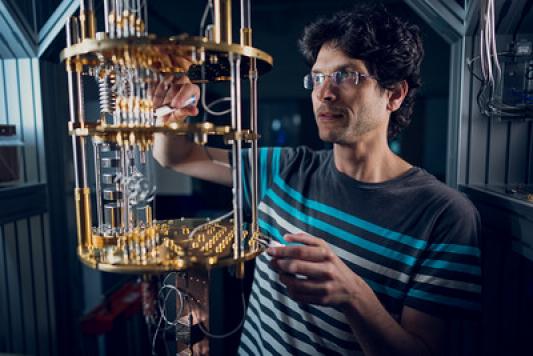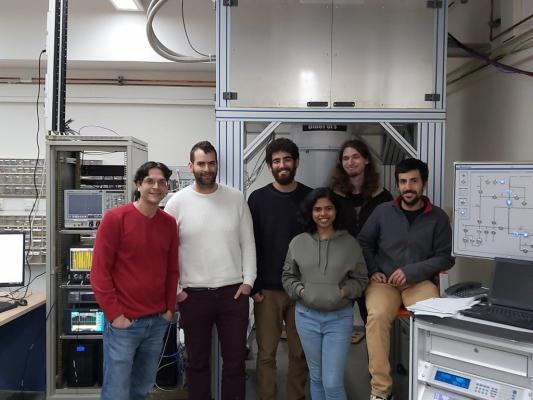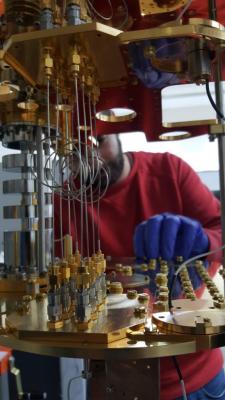One of the hottest topics in science today is quantum computing, where a quantum computer can solve certain calculations at a speed and scale that no ordinary classical computer can handle, using quantum mechanical principles (Read More>>)
A fundamental quantum mechanical principle is the superposition principle that states that a quantum particle can not only be in its given allowed states, but also in a combination of them. For example, the classical computer uses classical bits that are in either one of two states, 0 or 1, whereas the basic unit of quantum information, the qubit (quantum bit), can be in one of the two possible states (0,1) and also in a superposition of both states until the system is measured.
The need for quantum computers was raised by Paul Benioff and Yuri Manin in 1980 and soon after by Richard Feynman in 1982. The understanding that classical computers are inadequate for quantum systems due to their complexity led to the ideas of directly using that complexity for simulation and computation.
Quantum mechanics is usually considered in microscopic systems at the atomic or molecular scale. In the mid 1980s it was realized that “large” macroscopic systems of several hundred microns in scale can mimic the quantum nature of atoms and produce highly efficient quantum computations by using electric circuits that contain superconductors.
Superconductors are materials that in a temperature lower than a characteristic critical value the electrical resistance in them is exactly zero unlike in “normal” conductors, similar to an ice skater on a perfect ice course that will continue spinning forever. However, at that time there was great skepticism about the practicality of using these large circuits because of the coherence times, the time over which the state of a system is predictable and thus the computation is feasible, that were extremely short.
Over the last 20 years there have been many developments in the understanding of the circuit design and the materials which led to a significant increase in the coherence times in 5 orders of magnitude, from a nanosecond to 100 microseconds. In addition, in order to build a quantum computer there must be a clear and viable technological path. The path of superconductors seems to be very promising and as a result has stepped out of the academic realm.
As of today several groups in the industry are working on the matter including IBM, Google and Intel, pushing the research further. Yet, the viability of this path remains unclear and the academic research aimed at studying the fundamental physical aspects of quantum computing remains essential.
The laboratory of Professor Shay Hacohen-Gourgy in the physics department at the Technion is currently working on building a system that will be a conceptual basis for a quantum computer.
The research will lead to an improvement in the coherence times and also in the system components. Shay studied his PhD at the University of Tel Aviv in experimental solid state physics. During his studies he attended a lecture on the theoretical aspects of quantum computing that aroused his curiosity and led to a post-doctorate in the field in 2013 at the University of Berkeley, California. His main goal is to achieve a situation in which the system will be able to perform a simulation in the field of quantum computing, which will all be built in his lab from A to Z.
The system, that works in micro-wave frequencies, consists of circuits made of aluminum superconductors that act like atoms, "these are the qubits over which we will like to perform computational operations using logic gates" explains Shay. A qubit, as we know, is a quantum information unit and due to its quantum nature it must have discrete (distinct and different) energy levels. “We make sure of this in the lab by designing circuits with capacitors, inductors and advanced components (one of which is called a Josephson junction) using superconducting materials. Next, we control the “atoms” by photons in microwave frequencies which also allow the “atoms” to communicate with each other. In addition, for the system to behave in a quantum manner it must be cooled to very low temperatures of about 10 milliKelvin (about minus 273 degrees Celsius).”
The main goal of the first experiment will be to create an interaction between 4 qubits that do not “communicate” with each other. Shay: “The interaction is done by locally controlling and globally measuring – we control only one qubit but create an interaction between all qubits by simultaneously viewing all of them together such that the signal doesn’t distinguish between them. Usually, the qubits must be directly connected to each other so that we can apply a gate to them, here we only demand that we can control one qubit and observe all of them together”. This type of interaction is commonly called measurement-based entanglement, where the measurement itself - the observation of the system - creates the interaction. The idea for the quantum gate in the system termed a “Zeno gate”, originated during Shay’s postdoctoral period following the quantum Zeno effect, the quantum version of the (classical) Zeno paradox. One version of the paradox focuses on Achilles the fast runner that competes against a slow tortoise. Logically since Achilles is much faster he should eventually reach his opponent, but according to this paradox Achilles makes a fatal error and allows the tortoise to run ahead of him such that a gap will permanently remain between them. Every time Achilles reaches the point where the tortoise was previously the tortoise progresses further and Achilles never catches up to him.
The quantum Zeno effect states that if we observe a quantum system “fast” enough (or frequent enough, or “strong” enough) the system will not be able to change its state. “In other words,” explains Shay “the quantum Zeno effect “freezes” the evolution of the system and locks it in a certain quantum state (as in the Paradox where Achilles never reaches the tortoise)”. In the lab the Zeno effect is expressed in a dynamical manner (“Quantum Zeno dynamics”) where the strong observation blocks parts of the space in which the system evolves. As a result, we confine the evolution of the system to be in a certain subspace (the unobserved subspace to be precise), equivalent to “freezing” its state. This unique gate enables a multi-participant (multi-qubit) logic action in one step rather than doing many sets of 2-qubit gates as in the usual way.
In addition, Shay’s lab is currently working on optimization of quantum amplifiers that are necessary to process the quantum signal of the system. Shay next plans an experiment of increasing the number of quantum states in cost-effective ways that include manipulations on the rest of the system's components. A future distinctive goal is building new qubits with advanced materials. Such research advancements will play an important role in the future in making fully working quantum computers a reality.
For the original article, written by Dr. Efrat Sabach (department of Physics,Technion)- click here



